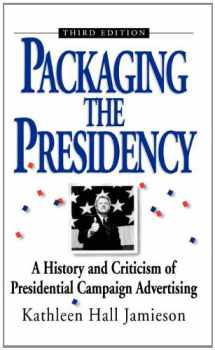
Packaging The Presidency: A History and Criticism of Presidential Campaign Advertising
Book details
Summary
Description
"If political advertising did not exist, we would have to invent it," writes Katherine Hall Jamieson in her widely praised study, Packaging the Presidency. Now in a new Third Edition, Jamieson expands her authoritative analysis of political advertising, looking at the media campaigns of American presidents from the early days of the republic to the successful 1992 Clinton campaign. Chronicling the evolution of the campaign ad from political songs and slogans through the handbill and newspaper cartoon to radio and television coverage, an argument emerges that is subtle but persuasive: though often equivocal, and even downright sleazy, political advertising is vital in reminding voters of the choices at the heart of democracy.
Much of the book, appropriately, focuses on the powerful media campaigns of the post-war period. In individual chapters devoted to presidential campaigns since 1952, the claims of media strategists, campaign memos, and journalists frame discussions on the impact of candidates from Adlai Stevenson, Richard Nixon, John F. Kennedy, and Ronald Reagan to the country's more recent high-profile and media savvy canditates such as Ross Perot and Bill Clinton. This new edition covers such issues as the new forms of exposition created by cable television that so powerfully impacted the 1992 campaign. The wide variety of venues, including MTV and the Nashville Network, coupled with almost daily appearances on morning talk shows, afforded candidates the ability to reach audiences by the millions in "news-ads" that served as free extended commercials. Jamieson points out the success of Ross Perot's unconventional revival of the thirty-minute program spot--an important innovation that reflected both the power of the modern-day "infomercial" and marked a radical change in previously held notions about the viewing electorate's response to longer forms of candidate sponsored communication. Jamieson also addresses the increasing prevalence of "adwatchs," in which the press polices the fairness and accuracy of campaign accusations, offering the public a greater opportunity to assess the claims made in political ads, and giving opponents the enhanced ablitity to use news corrections in counter ads. And we see how campaign intrigue reached a new high with satellite tracking that allowed candidates to capture copies of ads as they went on the air. "We would put ads on the satellite that we weren't going to run," recalls Clinton campaign manager James Carville, "just to freak them out. Fake spots, so they would have to put some time and money together and respond to it."
Just as political advertising is neither as innocent or invidious as it is frequently described, voters are more independent than cynics (and perhaps political advertisers) would like to believe. And as we approach the twenty-first century, with the cloak of television shadowing the country, voters are becoming increasingly more informed. As this fine study convincingly demonstrates, the successful "packaging" of presidents is a complex, and far from automatic, process.


We would LOVE it if you could help us and other readers by reviewing the book
Book review



